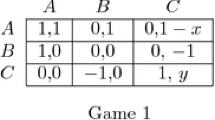Abstract
The limit of any convergent sequence of agent quantal response equilibria is a sequential equilibrium of an extensive game. Using a logarithmic transformation of action probabilities, it is numerically feasible and practical to compute such sequences, and thereby compute good approximations to sequential equilibrium assessments. This paper describes the algorithm to compute the sequences, and outlines the convergence and selection properties of the method.
Similar content being viewed by others
References
Allgower E.L., Georg K.: Numerical Continuation Methods: An Introduction. Springer, Berlin (1990)
Banks J., Camerer C., Porter D.: Experimental tests of Nash refinements in signaling games. Games Econ Behav 4, 1–31 (1992)
Brandts J., Holt C.A.: Adjustment patterns and equilibrium selection in experimental signaling games. Int J Game Theory 22, 279–302 (1993)
Koller D., Megiddo N., von Stengel B.: Efficient computation of equilibria for extensive two-person games. Games Econ Behav 14, 247–259 (1996)
Kreps D., Wilson R.: Sequential equilibrium. Econometrica 50, 863–894 (1982)
McKelvey, R.D.: A Liapunov function for Nash equilibria. Caltech Social Science Working Paper 953 (1991)
McKelvey R.D., Palfrey T.R.: An experimental study of the cenitpede game. Econometrica 60, 803–836 (1992)
McKelvey R.D., Palfrey T.R.: Quantal response equilibria for normal form games. Games Econ Behav 10, 6–38 (1995)
McKelvey R.D., Palfrey T.R.: Quantal response equilibria for extensive form games. Exp Econ 1, 9–41 (1998)
McKelvey R.D., McLennan, A.M., Turocy, T.L.: Gambit: Software Tools for Game Theory (2008). http://gambit.sourceforge.net
Miltersen, P.B., Sorensen, T.B.: Computing a quasi-perfect equilibrium of a two-player game. Econ Theory, this issue (2009)
Selten R.: Reexamination of the perfectness concept for equilibrium points in extensive games. Int J Game Theory 4, 25–55 (1975)
Turocy T.L.: A dynamic homotopy interpretation of the logistic quantal response equilibrium correspondence. Games Econ Behav 51, 243–263 (2005)
Author information
Authors and Affiliations
Corresponding author
Additional information
The author thanks the associate editor and two anonymous referees for helpful comments towards improving the exposition.
Rights and permissions
About this article
Cite this article
Turocy, T.L. Computing sequential equilibria using agent quantal response equilibria. Econ Theory 42, 255–269 (2010). https://doi.org/10.1007/s00199-009-0443-3
Received:
Accepted:
Published:
Issue Date:
DOI: https://doi.org/10.1007/s00199-009-0443-3




